“It’s like an Easter egg hunt!”
Those were the words of Benny Pausanos, Senior Fresh Rescue Driver at the Food Bank – and he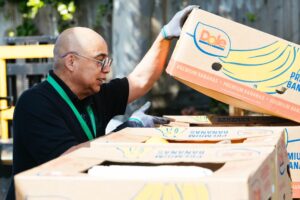 meant it quite literally. On a sunny Wednesday morning in April, Benny was busy digging through banana boxes in a Trader Joe’s parking lot, searching for stray cartons of eggs while repackaging a caseload of donated groceries.
meant it quite literally. On a sunny Wednesday morning in April, Benny was busy digging through banana boxes in a Trader Joe’s parking lot, searching for stray cartons of eggs while repackaging a caseload of donated groceries.
Benny’s quest might not immediately seem like a climate-related activity. But when it comes to fighting the climate crisis, food banking might be a bigger part of the solution than many realize. This Earth Day, let’s take a tour of Food Bank programs – and learn how many of them double as climate solutions.
Farm to Family
Worsening food insecurity and inequitable food access are closely linked to the climate crisis. As farmers struggle to adapt to changing climate conditions, crop shortages can cause prices to skyrocket. When the buck gets passed to the consumer, these rising prices hit our low-income neighbors the hardest and exacerbate hunger in our community.
One way we’re fighting this food access barrier is through the Farm to Family program, founded by former Food Bank Board member Gary Maxworthy and run by the California Association of Food Banks (CAFB).
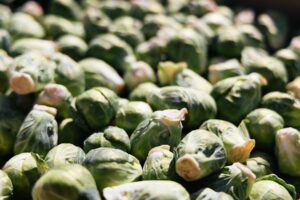
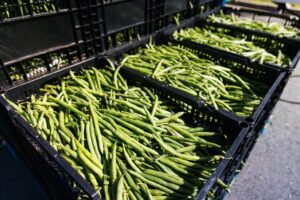
Farm to Family connects food banks with California growers. When farmers can’t send produce to stores because of size or ‘beauty’ requirements, we can purchase that for pennies on the dollar. This allows us to supply beautiful, farm-fresh produce that our participants can choose from year-round.
Last fiscal year, we diverted 40 million pounds of food through the Farm to Family program, bringing more than 40 types of delicious fruits and vegetables into our neighbors’ homes. But we’re not only fighting the ongoing effects of the climate crisis – we’re also taking preventative measures to avoid warming our climate further.
Fresh Rescue
As food spoils, it emits methane – a greenhouse gas 20 times more potent than carbon dioxide, and a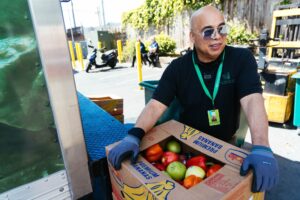 major factor in the worsening climate crisis. But what if, before it spoils, that food could make it onto the tables and into the stomachs of our neighbors across San Francisco and Marin?
major factor in the worsening climate crisis. But what if, before it spoils, that food could make it onto the tables and into the stomachs of our neighbors across San Francisco and Marin?
Enter the Food Bank’s Fresh Rescue program. Every day, Benny and our Fresh Rescue team make the rounds at stores like Trader Joe’s, Whole Foods and Safeway to sort through boxes of donated bulk produce, dairy products, proteins and baked goods that otherwise would go to landfill.
“I’m the link to help transport and qualify these donations,” Benny explained. Stores may donate items for a variety of reasons – whether they’re approaching expiration or have slight imperfections – and
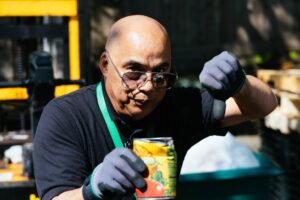
Benny goes through every item individually. “We’re just trying to make the right decisions to feed people good quality food.”
For donations that aren’t up to quality standards for our neighbors? We send unusable bread and produce to our partners at Marin Resource Recovery Center and Silva’s Ranch, where it becomes feed for pigs, cows, chickens, sheep, goats and even peacocks. Marin Resource Recovery Center, along with Recology SF, also helps sort, compost and recycle our remaining cardboard and other inedible grocery items.
More Choice, Fewer Emissions
After inspection, high-quality donations come back to the warehouse. Some donations will go out to our pantry network, providing neighbors with additional grocery options on top of farm-fresh produce,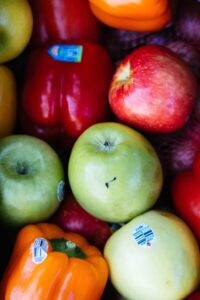 whole grains and proteins.
whole grains and proteins.
Other donations are funneled through our Shop Floor program. Our shop partners – community organizations who provide non-pantry services like hot meal sites and after-school snacks – can stop by our warehouse for free produce, bread for 8 cents/pound, and all other items for 18 cents/pound. “It’s all beneficial,” said Benny. “They can pick and choose what they can take for their programs. I think it’s impactful in that way – they have that extra variety to source from.”
Giving our neighbors more variety and choice is always a win in our book. Plus, our Fresh Rescue program helps permanently avoid the production of harmful greenhouse gas emissions. Food Bank Fresh Rescue staff diverted four million pounds of food from rotting in landfill last fiscal year – that’s the equivalent of protecting 4,000 acres of forestland.
Energy Efficient Improvements
Our programs aren’t the only thing keeping us green! With the generous support of Capital Campaign donors, we expanded and redesigned our San Francisco warehouse to store more fresh produce, serve 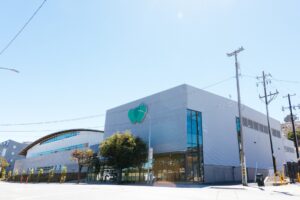 more people, and save more energy. Now, we’re building on that momentum by installing solar panels at our San Rafael warehouse!
more people, and save more energy. Now, we’re building on that momentum by installing solar panels at our San Rafael warehouse!
“Solar energy is a renewable resource that produces clean electricity without emitting greenhouse gases or other pollutants. By harnessing solar power, we’ll be reducing the carbon footprint of our San Rafael warehouse and contribute to environmental sustainability,” shared Carmelo Riyel Santo-Tomas, Senior Associate Director of Facilities at the Food Bank.
Alongside sustainability-focused building improvements, our drivers are optimizing their routes to eliminate back-tracking and save on fuel costs. And in the next year, we’re looking forward to welcoming new electric vehicles into our fleet of trucks – another move towards energy efficient transportation.
Climate Impact in Community
We’re proud of our work to become a more climate-conscious organization, but we recognize we have a long way to go. Looking to the future, we’re continuing to explore how to reduce food waste, implement energy efficient storage and transportation, and partner alongside farmers and community organizations who share our desire for a positive climate impact.
Just as food banks can’t end hunger alone, we can’t fight the climate crisis alone. Together with our participants, partners, staff and community, we are committed to doing our part to support the well-being of our neighbors and the planet. Happy Earth Day!



Share